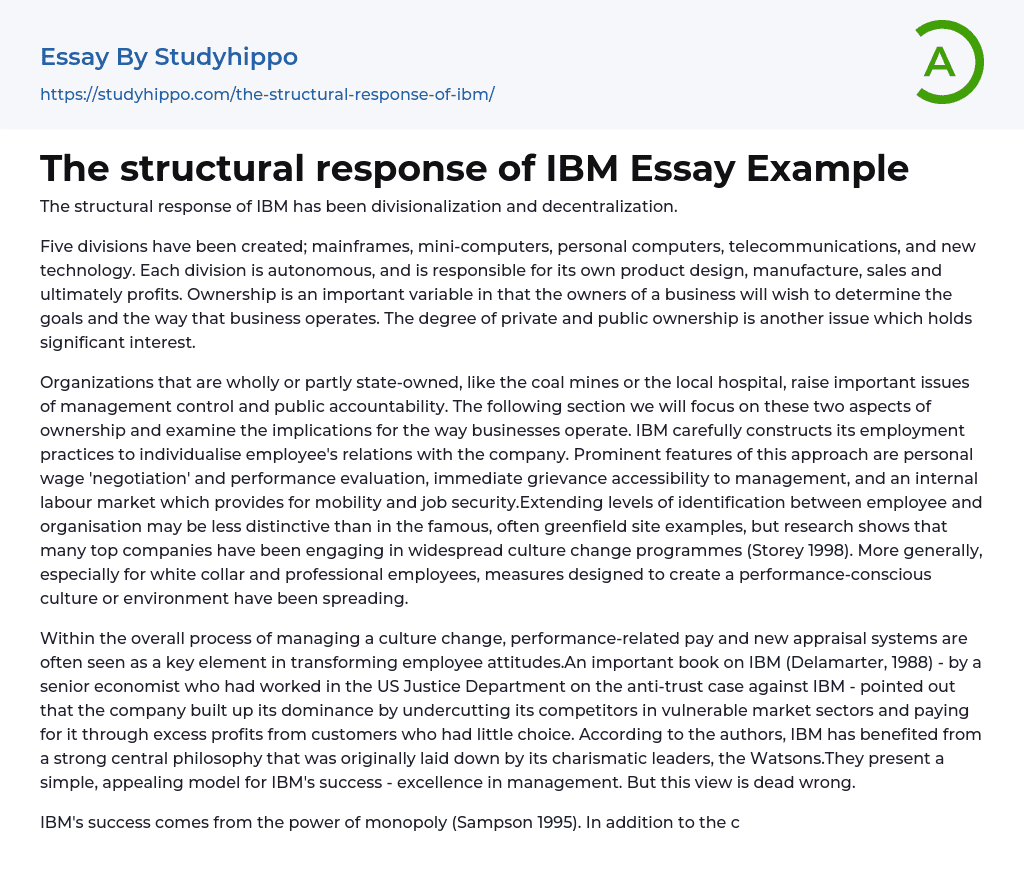IBM has responded to structural changes by decentralizing and dividing its organization.
The establishment of five independent divisions - mainframes, mini-computers, personal computers, telecommunications and new technology - has led to each division being responsible for their own product design, production, sales and profits. The ownership of a business determines its goals and operational procedures with the degree of privatization or public ownership also being important considerations.
In the following section, we will examine the significance of management control and public accountability in state-owned or partially owned organizations like coal mines and local hospitals. IBM takes a customized approach to managing its employees which involves wage negotiation, accessible grievance handling, an internal labor market that provides job security and mobility. Though not as apparent as greenfield site cases, many leading companies are implementing culture change programs to promote employee-orga
...nization identification (Storey 1998). Additionally, performance-based metrics are gaining popularity especially for professional and white-collar workers.
When managing a culture change, utilizing performance-related pay and implementing new appraisal systems is often a crucial aspect in transforming employee attitudes. Delamarter's (1988) book examines IBM, written by a senior economist who previously worked on the anti-trust case against IBM in the US Justice Department. Delamarter points out that IBM became dominant by undercutting competitors in vulnerable market sectors and funding it through excess profits from customers who had limited options. The authors attribute IBM's success to their charismatic leaders, the Watsons, and a strong central philosophy centered on proficiency in management. However, this belief is incorrect.
According to Sampson (1995), IBM's success is attributed to their monopoly power. Aside from typical outsourced services like catering and IT, they have also outsourced a range
of HR functions including training, retirement planning, relocation, counselling, and consultancy. Workforce Solutions was established in 1992 as a spin-off company by IBM.
Workforce Solutions was contracted by IBM to outsource its HR staff functions. However, Workforce Solutions can also offer its services to other clients. The following section explores IBM's national differences using Hofstede's four dimensions analysis. This analysis defines national culture as a collective mental programming, influenced by shared history and reinforced through cultural institutions in everyday life. The four dimensions were established through employee surveys conducted in the early 1970s across 40 countries, including IBM employees. Given IBM's strong corporate culture, any significant national variations would highlight the potential power of national culture as a contingency variable over variables proposed in the bold hypothesis (e.g.
Hofstede's approach was not the only one, but it was groundbreaking and has been widely discussed and disseminated. From Hofstede's interpretation of factor analysis come four dimensions. Firstly, power distance refers to the extent to which power in society is perceived to be unevenly distributed. Countries with large power distances espouse inequality; superiors may view subordinates as different types of people, and few individuals should have independence because power is an essential fact of life. Secondly, uncertainty avoidance indicates the degree to which national members feel threatened when confronted with indefinable and ambiguous situations that they try to avoid.
One way to avoid issues is by creating strict regulations and not accepting nonconformity. If a country's uncertainty avoidance level is low, they would opt for fewer rules that are adaptable, willing to take chances, accepting of opposing views, and believe the role of authority is to benefit everyone.
- American Dream essays
- Barriers To Entry essays
- Capitalism essays
- Central Bank essays
- Compensation essays
- Consumerism essays
- Economic Development essays
- Economic Growth essays
- Economic Inequality essays
- Economic System essays
- Economy essays
- Employment essays
- Export essays
- Finance essays
- Free Trade essays
- Gross Domestic Product essays
- Human Development essays
- Income Inequality essays
- Industry essays
- Inflation essays
- International Business essays
- International Trade essays
- Macroeconomics essays
- Materialism essays
- Max Weber essays
- Microeconomics essays
- Minimum Wage essays
- Monetary Policy essays
- Monopoly essays
- Pricing essays
- Profit essays
- Recession essays
- resources essays
- Taxation essays
- Trade essays
- Unemployment essays
- Warehouse essays
- World economy essays
- Ben jonson essays
- Billy elliot essays
- Dred Scott essays
- Frederick Douglass essays
- Geert Hofstede essays
- George Eliot essays
- Ginevra King essays
- Harriet Tubman essays
- John Keats essays
- John Proctor essays
- Joseph Stalin essays
- Mahatma Gandhi essays




